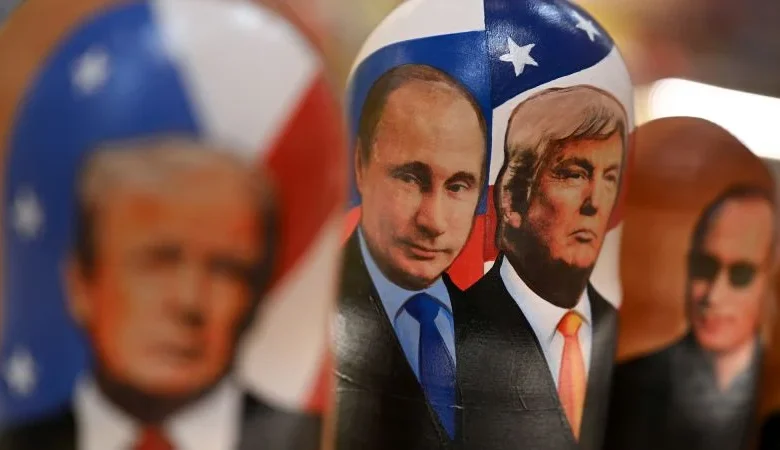Trump is giving Russia almost everything it wants with his Ukraine peace plan

Trying the same thing over and over again, without success, is either the definition of insanity or Russian negotiation tactics, depending on your point of view.
The widely leaked draft of President Donald Trump’s 28-point plan is a terrifying leap backwards for Kyiv. It was co-conceived by Russians who wanted to pretend they were engaging in peace, and circulated by Ukrainians and Europeans who felt it was so ridiculous it would surely die on first contact with oxygen.
Much of the text resembles the maximalist positions Russia held during talks in Istanbul in 2022 when its forces held more of Ukraine, and the slow, grinding military embarrassment of the past three years was still ahead of them. Before we dissect the text – and its profound, dizzying advantages for the Kremlin – the timing of this renewed, mostly Moscow-initiated plan, is key.
Russia’s forces are perhaps in their best position for about a year. They are weeks, even days, away from taking the embattled eastern military hub of Pokrovsk, a place of outsized significance and great strategic import, grimly fought over since last summer. Their forces are at its southern edges, and if they take it would encounter few sizeable population centers to their west that are under Ukrainian control before they near the capital, Kyiv. That land is mostly flat and open, ideal for a swift advance. Moscow has also had a breakout across Zaporizhzhia region, using armor and moving its forces perilously close to Zaporizhzhia city, taking, again, open and flat territory that will remain vulnerable during winter.
Ukraine continues to see high desertion rates and draft-avoidance, adding to its serious manpower issues and Kyiv’s drone advantage has been eroded by swift Russian learning and innovation. President Volodymyr Zelensky is also suffering a popularity nadir – facing the repercussions of an ongoing and intimately detailed corruption scandal that touches both his inner circle and the very thing Ukrainians must endure daily – energy outages.
The Russian initiative is obviously set to exploit Ukraine’s moment of perhaps unprecedented vulnerability – when a domestic political crisis threatens to hobble Zelensky in confronting frontline emergencies. The appalling timing for Kyiv may also explain why Moscow has bothered to – yet again – present a series of maximalist demands that Ukraine and its allies have also flatly and repeatedly dismissed. One European diplomat described it as Groundhog Day. But in the movie, the rub of that day on repeat was not that it became predictable and tedious, but that you were forced to constantly relive it.
The 28 leaked points serve two purposes for Moscow. They present a starting block that is so advantageous that even achieving parts of it would be a huge win. And they also provide an edifice to which Russian diplomats can constantly return if they wish to, yet again, slow-roll diplomacy while their military has the advantage.
Demands that Ukraine constitutionally reject NATO membership, de-Nazify, guarantee its neutrality and limit the size of its armed forces were in the Istanbul 2022 document. Then, at the height of the Russian invasion’s initial ambition they were an amorphous set of maximalist terms that amounted to a form of Ukrainian surrender.
Ukraine has survived formidably since that gambit but has been weakened by the fight.
The use of $100 billion in frozen Russian funds to rebuild Ukraine appears, on the surface, to be a Russian concession. Yet the most brutalized parts of Ukraine are under Russian occupation, and this money would go to Russia to execute the rebuild under its terms. The deal proposes that half of any reconstruction profits would somehow go to the United States, and some of the money would be invested in other joint US-Russian projects. The scope for Moscow getting much of this cash back is vast, and the deal also proposes that international sanctions be lifted entirely, which would be a huge financial boon of its own.
There are three other hidden shards of glass in this repeat serving of Russian diplomatic porridge. First is the demand for elections 100 days after a deal’s signature.
This is, by most accounts, technically impossible given the challenges of demobilization, war-time logistics and legal reform. A rushed, poorly executed poll would be the outcome, yielding a government of questionable legitimacy and providing a space for misinformation and manipulation large enough for the Russians to drive another tank through, with their preferred candidate sat on top. Zelensky cannot accept this deadline, and a snap election was a Russian canard from earlier this year that the Trump administration seemed to drop. Its revival – and with it, discussion of Zelensky’s shelf life – re-emerges at a time of new weakness for this wartime leader.
Second is the confusing concept of turning the parts of the eastern Donbas region currently under Ukrainian control into a demilitarized zone that is technically part of Russia. This amounts to surrendering them to Russian “civilian” forces. This is terrain Moscow would otherwise have to bitterly fight for over the next year. Even a compromise of declaring this area a demilitarized zone, from which the militaries of both sides are barred, feeds into Russia’s rich history of using “people’s militias” to infiltrate territory and declare a popular revolt in Moscow’s favor.
Zelensky cannot cede the city of Kramatorsk. It would yield Russian President Vladimir Putin a military bulwark from which to launch another, easier attack toward Kyiv across open ground, perhaps within months. It would open Zelensky up to internal political challenges. Moscow knows this, but keeps going back to it in the hope that eventually Trump is ground down into seeing this concession as a necessary part of any solution.
Thirdly, the wording of the circulated deal is vague, and seems at times to be rush-translated from Russian or Ukrainian, containing several “snapback” clauses. One says Ukraine’s security guarantees will be “deemed invalid” if they fire a missile at “Moscow or St. Petersburg without cause” – a caveat of great consequence and breadth of interpretation. Russia will have a different view of what “cause” is great enough to that held by Ukraine.
The deal also demands all “Nazi ideology and activities must be rejected or prohibited” in Ukraine, a repeat of the Russian false talking –point that it is facing a Kyiv government run by Nazi extremists. Would the appearance of a far-right flag on a Ukrainian unit, or an SS Death’s Head emblem in an unofficial military Telegram page, suddenly void the deal? In its current form, the deal is something Moscow can walk out on at any time, with slim justification.
If there is any Russian error in this document, it is not in its timing, or blunt obstinacy, but in its clear exposition that Moscow retains most of its maximalist demands as its starting point. That has in the past angered Trump, and indeed resulted in the most severe sanctions imposed yet by the US on Russia, against oil giants Rosneft and Lukoil.
But the Kremlin has correctly seen its steep advances on the battlefield, Ukraine’s domestic turbulence and serious frontline fragility, Europe’s concerns about how long it can fund Kyiv’s defense, and Trump’s overwhelming hunger for a Nobel Peace Prize in 2026, and tried to make the old sound new again.
If it buys time, it works. If a third of it sticks, or becomes the lexicon of any future deal, it works. In the past year, almost everything else has been tried once. So, for Moscow, trying the same old, bad idea again makes total sense.





